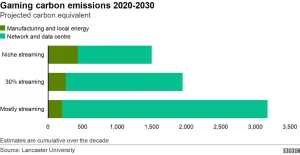Is Sustainable Play to Earn Game Possible?
Play-to-Earn (P2E) games are a groundbreaking and innovative thing in the gaming industry. With these P2E games, players can earn real-world money by simply doing what they like. Because these games offer so much, i.e., financial rewards, an opportunity to develop skills, economic empowerment, and, of course, playing games, many people have started venturing into the world of P2E games. But just because something is famous does nothing to assure its sustainability. In today’s article, I will dive into the pros and cons of P2E games, examining their impact on players, the industry, and the environment, along with the factors that affect its sustainability and the future trends that might affect the P2E game sustainability. Let’s see if sustainable play to earn game possible or not?
The Pros of Play-to-Earn Games
Play-to-Earn (P2E) games have gained huge popularity because of the many advantages they offer to players and the gaming industry.
Financial Opportunities
One of the most attractive aspects of P2E games is the fact that they allow players to earn real money. Players can convert in-game assets and currencies into cryptocurrencies or traditional fiat, turning their in-game assets into an additional income stream. This has empowered gamers to turn their passion into a part-time or even full-time profession. Not just this, but P2E games have resulted in not just one but many job opportunities, from game testers and streamers to market analysts and developers. This ecosystem has created employment opportunities for people both within and outside the traditional gaming space, further contributing to economic growth.
Incentivizing Skill Development
P2E games often reward players based on their in-game achievements and skills. This encourages players to improve and master the game, developing their cognitive and strategic skills. In contrast to traditional gaming, where rewards are just within the game and have no real-world value, P2E games offer tangible benefits for developing one’s skills. Furthermore, P2E games level the playing field by allowing players to earn valuable assets and income based on how good they are. This creates a competitive advantage for dedicated players who put in the effort to improve their gameplay. This helps to develop a culture of healthy competition and gameplay.
Economic Empowerment
P2E games provide players, especially those in regions with limited access to traditional financial services like banks, with access to the global economy. Players can participate in digital financial transactions, earn money, and access banking services through these games, promoting financial inclusion. Not only this, but P2E games offer a unique opportunity for people of diverse backgrounds to overcome economic differences and disparities. Gamers from marginalized communities can earn income and improve their living standards, reducing economic inequality and promoting financial equity.
The Cons of Play-to-Earn Games
While P2E games offer some very attractive prospects, they also raise concerns regarding their sustainability and impact on players and the gaming ecosystem.
Risk of Exploitation
Some argue that P2E games blur the line between entertainment and work, as players have to spend a lot of time and effort to earn rewards. This can lead to the exploitation of players, becoming something like an unregulated gig economy where gamers might be at risk of overexertion. Not only this, but P2E games often rely on in-game purchases and microtransactions, which can be addictive and encourage excessive spending. This creates concerns about vulnerable people, including younger players, falling into financial traps.
Impact on Traditional Gameplay
The hunt for profit can sometimes compromise the integrity of game design. P2E games may prioritize monetization strategies over gameplay quality, leading to dissatisfaction among gamers who prefer traditional, skill-based competition. Furthermore, P2E games can create an uneven playing field, where players who invest more money start getting an unfair advantage. This pay-to-win dynamic can discourage skill development and alienate those who cannot afford to compete financially.
Environmental and Economic Concerns
Many P2E games are built on blockchain technology, which consumes a very large amount of energy. The environmental impact of energy-intensive blockchain operations raises concerns about the sustainability of P2E games, especially in a world increasingly focused on environmental responsibility. Another concern is the value of in-game assets and cryptocurrencies within P2E ecosystems, which can be highly unstable, leading to theoretical bubbles that can burst and result in significant financial losses for players. These economic risks highlight the need for sustainable monetization models and responsible investment practices in P2E gaming.

Factors of a sustainable play to earn game
Having a sustainable play to earn game is a complex issue, with various factors that determine its long-term viability and impact. Let’s see the critical aspects that contribute to the sustainability of P2E games.
Balancing Profit and Play
For a sustainable play to earn game, they must strike a balance between profitability and player satisfaction. This means implementing monetization strategies that are fair and transparent, ensuring that players can reasonably earn rewards without being forced into excessive spending. Encouraging skill-based rewards can promote sustainable gaming. Games that offer good earnings for in-game achievements rather than solely relying on financial investments tend to have a more loyal player base. To further enhance sustainability, P2E games should take measures to prevent a pay-to-win environment. This includes stopping the financial advantage players can gain and ensuring that skill and dedication remain key factors in moving forward in the game. Also, P2E game developers must consider the long-term sustainability of their projects. This means continually updating the game, introducing new content, and keeping the player community engaged.
Regulation and Accountability
P2E games need clear legal frameworks and regulations to make sure that players are protected and the industry works responsibly. Government authorities worldwide are inspecting blockchain-based games and NFTs more and more, which means that responsible regulation is very important to the long-term sustainability of P2E games. This regulation can introduce consumer protections against scams, and unfair monetization practices and ensure that players are not taken advantage of. A good way to do this is by implementing AML and KYC procedures, both of which can enhance the credibility and sustainability of P2E games by mitigating risks associated with illegal activities and fraud. AML (Anti-Money Laundering) procedures are measures to detect and prevent money laundering, while KYC (Know Your Customer) procedures are steps taken to verify the identity of customers to mitigate financial risks.
Environmental Sustainability
The environmental effects of blockchain technology used in P2E games is a very big concern. Sustainable P2E games will need to adopt energy-efficient blockchain solutions or explore alternative technologies to minimize their carbon footprint. Transitioning from energy-intensive PoW (Proof of Work) blockchains to PoS (Proof of Stake) or other energy-efficient consensus mechanisms can significantly reduce the carbon footprint of P2E games. Some projects are exploring carbon offset initiatives too, where they invest in renewable energy or conservation projects to lower the environmental impact of their operations as much as possible. The P2E industry is actively addressing the environmental challenges it poses. As a sustainable future becomes increasingly important, blockchain technology in P2E games is evolving to become more energy-efficient and environmentally responsible.
Sustainability in P2E games is a multifaceted challenge that requires a careful blend of responsible business practices, player protection, and environmental responsibility. The industry’s ability to adapt and find solutions to these challenges will determine its long-term success and impact.
Future Trends and Challenges for any sustainable play to earn game
The future of Play-to-Earn (P2E) games is a picture that continuously keeps on changing. There is no guarantee, but we sure can predict the future of P2E games. So here are the potential trends and challenges that will shape the P2E gaming industry in the coming years.
As technology evolves, P2E games are likely to take part more into the metaverse concept. Virtual worlds will become more immersive and interconnected, potentially offering players a seamless experience as they transition between different games and platforms. The concept of a metaverse represents an exciting future for P2E, blurring the lines between virtual and physical reality. Not just this, but technological advancements are bound to improve the user experience in P2E games. User interfaces and gaming mechanics will continue to change, making the experience more engaging and user-friendly. Moreover, innovations in blockchain technology and smart contracts will streamline in-game asset ownership and trade, reducing transaction costs and improving security.
Yet, as the P2E industry evolves, it also faces potential threats. Regulatory changes are a huge concern right now. Governments and financial institutions are closely monitoring cryptocurrency-related activities, and P2E games are no exception. Evolving regulations may impact the industry’s ability to operate in certain regions or require better compliance measures. Market saturation is also another challenge. The rapid production of P2E games could lead to oversaturation, making it challenging for new projects to gain traction. Furthermore, the influx of low-quality or fraudulent P2E projects poses risks to players and the industry’s reputation.
In this ever-changing landscape, P2E games must remain adaptable, responsible, and player-focused. The industry’s ability to embrace emerging technologies and navigate regulatory hurdles will determine its long-term success and sustainability, while maintaining an immersive and enjoyable experience for players.


